The possible reason the dishwasher is not cleaning the top rack is obstruction. Tall items placed on the bottom rack of the dishwasher block the spray from rotating.
The water from the spray arm will not reach the dishes on the top rack. Ensure the upper spray arm can spin freely if the dishwasher is loaded with tall items.
Why Is The Dishwasher Not Cleaning The Top Rack?

Obstructed Spray Arm:
If your dishwasher is not cleaning the top rack, look for obstructions first.
The spray arm can be obstructed by tall items in the bottom rack. The water from the spray arm will not reach the dishes on the top rack.
Ensure the upper spray arm can spin freely if the dishwasher is loaded with tall items. If it’s obstructed, either move the tall item or wash it by hand.
Clogged Propeller Jets Under The Rack:
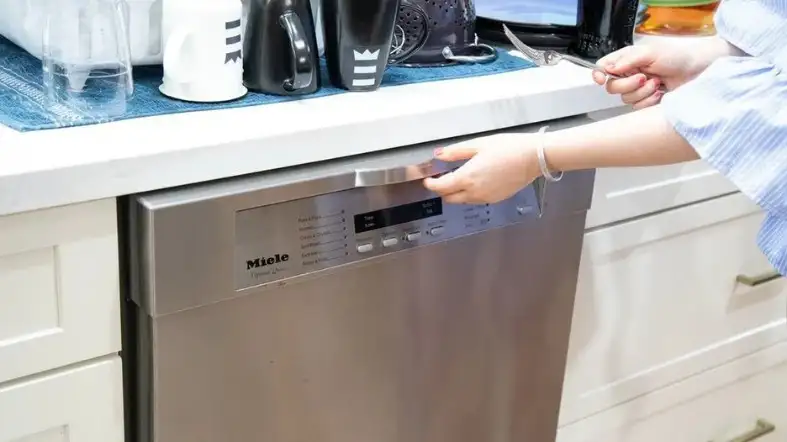
Have you ever wanted to know how dishwashers work? It’s all about the spray jets in the end!
Dishwashers with high-pressure water jets clean the dishes.To get a good cleaning solution, the spray nozzles must be directly aimed at the dishes.
A jet sprayer with a variety of jets should be installed beneath the top rack of a dishwasher to clean all of the dishes on top.
In many areas, hard water is a big problem. The biggest issue is mineral buildup around the spray holes when the water is hard.
Water flow can be restricted if minerals are present in the water near the spray holes.
Here’s what you should do if you face this kind of problem: turn off the power before you begin disassembling it. Even if the dishwasher appears unplugged, you must still turn it off!
If the water is delivered to the top-rack sprayer, disconnecting it is simple; underneath it, you’ll find a sprayer.
Check to see if the sprayers are operational. If they become clogged, locate and remove the mineral buildup.
Replace the sprayer and test it for functionality.
Broken Or Damaged Spray Arm Seal:
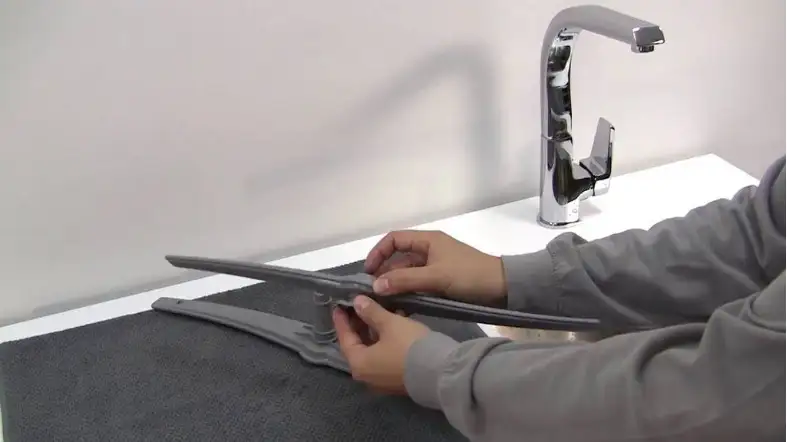
The spray arm seal on your dishwasher should keep it from leaking, but you’ll need to replace it if it breaks.
If your seal fails, then water will simply leak out from the spray arm and away out from dishes in your top rack.
The spray arm seals on most dishwashers are simple to work with and inexpensive to replace.
Solution:
To troubleshoot the problem of broken seals, the following steps must be followed:
- Unplug your dishwasher
- Remove the top rack
- Find the connector arm for the spray arm
- The two screws that keeps the cover in place must be removed.
- Remove the connector arm with a flat head screwdriver.
- Using a damp cloth, clean the spray arm assembly.
- Place the new seal on the connector arm and tighten it.
- With the two screws that came with it, reattach it to the cover.
- Return the top dish rack to its original position.
The Spray Arm Is Clogged
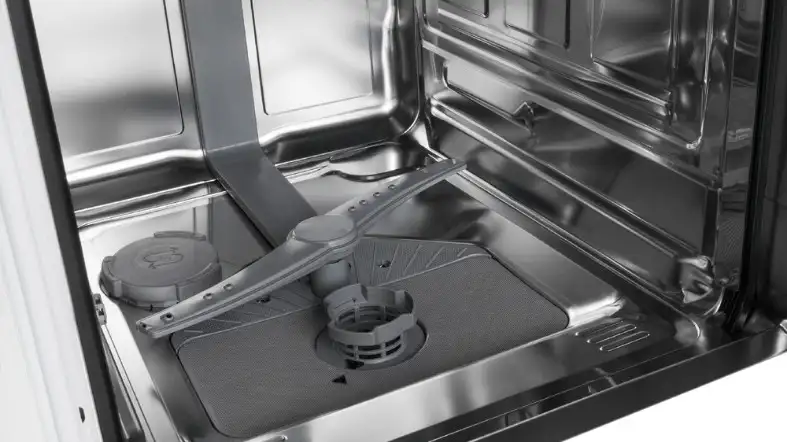
The upper spray arm can become clogged due to hard water, detergent residue, or food.
There might be a problem with low water pressure if your dishwasher doesn’t clean dishes well on the top rack.
The water in the dishwasher is usually evenly distributed between the bottom and upper racks.
If your water pressure isn’t high enough, you won’t be able to fill both racks. The bottom rack of the dishwasher will most likely be clean, but the top rack will remain dirty.
Solution:
Remove The Top Spray Arm:
You may need to use a ratchet and socket to remove the top arm. Depending on the model of your dishwasher, you may require a different size socket.
Using a socket and ratchet, remove the clamp and arm from the side of the machine once the arm is removed from the dishwasher.
Clean The Holes In The Spray Arms:
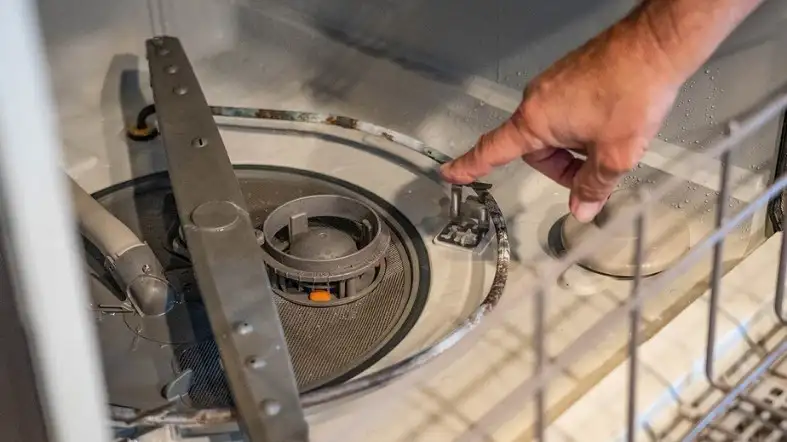
You’ll need a wire or hanger to remove the arm from the dishwasher. If it’s a steel appliance, use steel wire; use a cheap metal hanger if it’s a plastic appliance.
Bend the wire or hanger to fit inside the jet holes and dislodge any food, minerals, or detergents that have gotten stuck there.
Take it to the company’s store if you need a wire and aren’t sure what size will fit.
Wash The Spray Arm:
Next, remove the wire and as much food and debris as possible from the dishwasher arm.
After that, soak the arm in white vinegar to clean it out and eliminate any remaining food particles.
You can do this when your sink is full of water and vinegar or a baking dish. After soaking the arm for 10-15 minutes, place it back in the dishwasher.
Water Inlet Valve Fault
After running your dishes through the dishwasher, they will be spotless, but only if the dishwasher is equipped.
The sprayers in the dishwasher are on the top rack. There must be a lot of water pressure for it to work.
The dishwasher gets all of its water from the water inlet valve. Check the water hose for damage before attempting to replace or remove your water inlet valve.
If you notice a leaking hose, replace it as soon as possible. To obtain information about the part you’ll need, you’ll need to contact the dishwasher’s manufacturer.
Check the previously mentioned parts to ensure they’re all in good working order. If they aren’t, a lack of consistent water pressure or a complete lack of water is the following option.
After double-checking everything and determining that the water inlet valve is indeed faulty, the valve needs to be replaced. You’ll want to make sure you have all of the tools, supplies, and parts you’ll need to get started.
Before you begin any work, ensure that the breaker in the electric panel is turned off.
The water inlet valve is installed on the bottom of your dishwasher. It’s difficult to remove because it’s held in place by screws.
Remove the screws that hold the bracket to the dishwasher frame with your tools, such as a screwdriver.
Remove the hose clamp and unscrew the old one after pulling out the inlet valve.
Reverse the steps to install the new valve and reconnect all connections. Check to see if the dishwasher runs smoothly after you’ve re-powered it.
Circulation Pump Fault
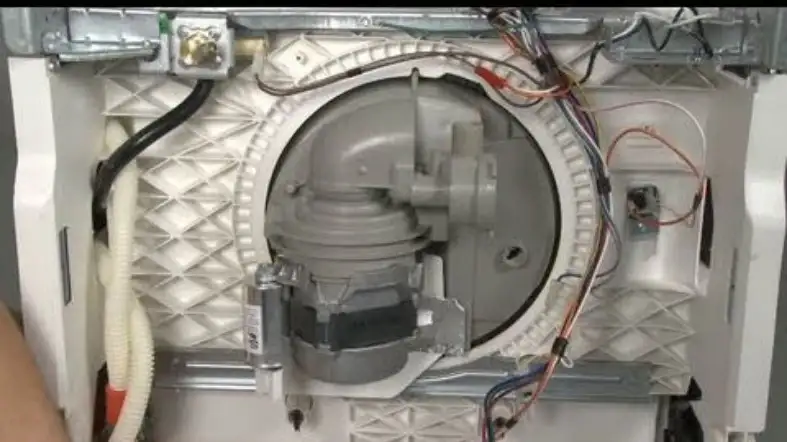
The circulation motor in your dishwasher has most likely failed if you hear it filling up with water but not spraying within the first 30 seconds.
The circulation motor in your dishwasher has most likely failed if you hear it filling up with water but not spraying within the first 30 seconds.
Pumps are in charge of getting the water to the top spray arms. Dishwashers can’t clean dishes if they aren’t working.
Pumps can clog, preventing water from reaching the top arms and resulting in a filthy top rack.
Clear the clogs in the pump with a pipe cleaner or other tool if visible. The motor may have failed if the debris isn’t visible and the pump gets power. Either the pump or the motor should be replaced.
FAQs About Dishwasher Not Cleaning The Top Rack:
How Do You Take A Top Dishwasher Rack Apart?
The top rack rails are used to mount the upper rack. The end cap on the top rack rails can be pried off by having bending metal tabs at the rail’s end.
The rack will then pull out of the dishwasher while the rails remain inside.
Bending the rail tabs repeatedly will eventually break them, necessitating the replacement of the entire rail.
Is There Any Way To Run A Dishwasher Without Using The Top Rack?
The upper rack can usually be removed in most dishwashers.
Removing the top rack is a good option if you want to wash large stock pots or tall items like vases or platters.
What Is The Top Rack Wash Option On A Dishwasher?
By washing dishes in the top rack instead of the bottom, you save time and energy by not waiting for a full load to wash a few items.
Final words:
If your dishwasher is not cleaning the top rack properly, use the recommended fixing process above.
If these don’t work, then you will be needing further assistance.
You can contact a technician, or you may reach out to the brand for further instructions.
If your dishwasher still has a warranty, then reach out to your manufacturer for more recommendations.
